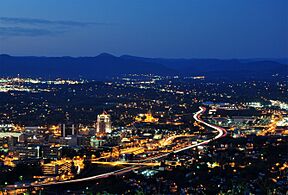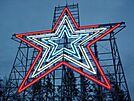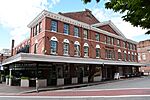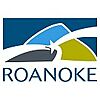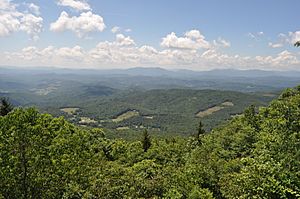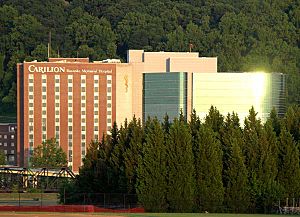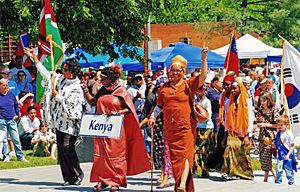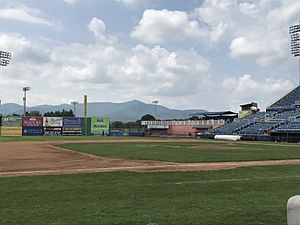Roanoke, Virginia facts for kids
Quick facts for kids
Roanoke, Virginia
|
|||||
|---|---|---|---|---|---|
|
Clockwise from top: Downtown Roanoke, City market building, Basilica of St. Andrew, Hotel Roanoke, Roanoke Star
|
|||||
|
|||||
| Nickname(s):
The Star City of The South, Magic City, Star City
|
|||||
| Country | United States | ||||
| State | Virginia | ||||
| Named for | Roanoke River | ||||
| Government | |||||
| • Type | Council–manager | ||||
| Area | |||||
| • Independent city | 42.85 sq mi (110.99 km2) | ||||
| • Land | 42.52 sq mi (110.13 km2) | ||||
| • Water | 0.33 sq mi (0.86 km2) | ||||
| Elevation | 974 ft (297 m) | ||||
| Population
(2020)
|
|||||
| • Independent city | 100,011 | ||||
| • Rank | 326th in the United States 8th in Virginia |
||||
| • Density | 2,333.98/sq mi (901.08/km2) | ||||
| • Urban | 217,312 (US: 177th) | ||||
| • Urban density | 1,731.6/sq mi (668.6/km2) | ||||
| • Metro | 315,251 (US: 163rd) | ||||
| Demonym(s) | Roanoker | ||||
| Time zone | UTC−5 (Eastern (EST)) | ||||
| • Summer (DST) | UTC−4 (EDT) | ||||
| ZIP Codes |
24001–24020, 24022–24038, 24040, 24042–24045, 24048, 24050, 24155, 24157, 24012
|
||||
| Area code(s) | 540, 826 | ||||
| FIPS code | 51-77000 | ||||
| GNIS feature ID | 1499971 | ||||
| Website | www.roanokeva.gov | ||||
Roanoke (pronounced ROH-ə-nohk) is an important city in Virginia, United States. It is an independent city, meaning it is not part of a larger county. Roanoke is found in Southwest Virginia by the Roanoke River. It sits within the beautiful Blue Ridge Mountains, which are part of the larger Appalachian Mountains.
Roanoke is about 50 miles (80 km) north of the Virginia-North Carolina border. It is also about 250 miles (400 km) southwest of Washington, D.C.. In 2020, Roanoke had a population of 100,011 people. This makes it the largest city in Virginia west of the state capital, Richmond. Roanoke is the main city in the Roanoke metropolitan area, which had over 315,000 people in 2020.
Long ago, the Roanoke Valley was home to the Tutelo tribe, who spoke Siouan. Later, in the 17th and 18th centuries, farmers from Scotland-Ireland and Germany moved into the area. They gradually pushed the Native Americans out as more settlers moved west. In 1882, the Norfolk and Western Railway (N&W) chose a small town called Big Lick for its main offices and railroad repair shops. Just two years later, Big Lick became the City of Roanoke. The city grew incredibly fast, earning the nickname "Magic City."
Over the years, Roanoke expanded its borders by adding land from nearby Roanoke County. It became a major center for business and culture in Southwest Virginia. In 1982, the N&W railroad moved its headquarters. This, along with other factories closing, led Roanoke to focus on a service economy. Today, a strong healthcare industry and outdoor activities have helped the city grow again.
Roanoke is famous for the Roanoke Star. This huge, 88.5-foot (27 m) tall star lights up a mountain within the city. It's why Roanoke is called "The Star City of the South." Other interesting places include the Hotel Roanoke, a historic hotel built in 1882. There's also the Taubman Museum of Art and the city's farmer's market. This market is the oldest open-air market in Virginia that has been running continuously. The Roanoke Valley also has 26 miles (42 km) of greenways for biking and walking. The city's location in the Blue Ridge Mountains means lots of chances for outdoor recreation.
Contents
Roanoke's Past: A City's Journey
How Roanoke Began and Grew
The town first known as Big Lick started in 1852. It officially became a town in 1874. The name "Big Lick" came from a large salt deposit. This salt attracted wildlife to the area near the Roanoke River. In 1882, the town changed its name to Roanoke. By 1884, it became the independent City of Roanoke.
The name Roanoke may come from an Algonquian word for shell "money." This name was used for the river by Algonquian speakers. They lived far away, where the river met the sea near Roanoke Island. The native people living near the city's founding spoke Siouan languages, like Tutelo and Catawban. There were also Cherokee speakers in the area.
Roanoke grew a lot by adding land from nearby areas. This happened often until the mid-20th century. The last time was in 1976. Since then, Virginia has stopped cities from taking land from counties. Roanoke's spot in the Blue Ridge Mountains made it a key transportation center. This helped it grow very quickly.
Early Roads and Trails in Roanoke
During colonial times, the area where Roanoke now stands was a vital hub for trails and roads. The Great Wagon Road was one of the busiest roads in 18th-century America. It ran from Philadelphia through the Shenandoah Valley. It ended at the future site of Roanoke City. Here, the Roanoke River passed through the Blue Ridge.
The Roanoke Gap was a useful path for settlers moving to the Carolina Piedmont region. Another part of the Great Wagon Road, called the Wilderness Road, continued southwest to Tennessee.
Railroads and Coal: Powering Roanoke's Growth
In the 1850s, Big Lick became a stop on the Virginia and Tennessee Railroad (V&T). This railroad connected Lynchburg with Bristol. After the American Civil War (1861–1865), William Mahone helped connect three railroads. This created the Atlantic, Mississippi and Ohio Railroad (AM&O) in 1870. It stretched from Norfolk to Bristol.
However, a financial crisis in 1873 hurt the AM&O. In 1881, a company from Philadelphia bought it. They renamed it the Norfolk and Western Railway (N&W). Frederick J. Kimball led the new N&W. He chose Big Lick as the meeting point for the N&W and another railroad. The grateful citizens wanted to name the town "Kimball." But he suggested Roanoke, after the river.

Roanoke became a city so fast that people called it the "Magic City." Kimball also helped develop the Pocahontas Coalfields. He extended N&W lines into West Virginia and other states. This made the railroad very successful.
The Virginian Railway (VGN) was another amazing railroad. It was built through Roanoke in the early 1900s. The VGN later joined with the N&W in 1959. The coal from these fields made N&W rich. It also made Pocahontas coal famous worldwide. This coal powered many ships and factories.
The Norfolk & Western was known for building its own steam locomotives. The Roanoke Shops built famous locomotives like the A, J, and Y6 classes. They built new steam locomotives until 1953. This was long after diesel-electric engines became popular. N&W was one of the last major railroads in the U.S. to switch from steam to diesel power around 1960.
The railroad also attracted factories to Roanoke. American Viscose opened a large rayon plant in 1917. This plant closed in 1958, leaving 5,000 people without jobs. When N&W switched to diesel, 2,000 railroad workers were also laid off.
Roanoke's Natural Surroundings
Geography and Mountains
Roanoke is the biggest city in Virginia west of Richmond. It is also the largest city located in the Blue Ridge Mountains. These mountains are part of the larger Appalachian Mountains. The city covers about 42.9 square miles (111 km2). Most of this is land, with a small amount of water.
Roanoke is in the middle of the Roanoke Valley. The Roanoke River flows through the city from west to east. Inside the city limits is Mill Mountain. This mountain is 1,700 feet (518 m) tall. It is a 500-acre (200 ha) park separate from the other mountains.
Roanoke's location in the Blue Ridge Mountains means it has many kinds of plants and animals. The area is home to at least 43 types of salamanders. The Poor Mountain Natural Area Preserve nearby protects the world's largest group of piratebush. This is a very rare plant found only in the Appalachians.
Roanoke is the largest city along both the Appalachian Trail and the Blue Ridge Parkway. The Appalachian Trail runs just north of the city. The Blue Ridge Parkway runs just south. Carvins Cove is the third-largest city park in America. It covers 12,700 acres (51 km2) and is near Roanoke. Smith Mountain Lake is also close by. The George Washington and Jefferson National Forests are also nearby. The area offers many chances for hiking, mountain biking, canoeing, kayaking, and other outdoor fun.
Roanoke's Neighborhoods and Historic Places
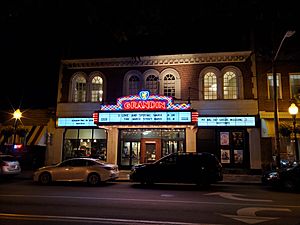
Roanoke has 49 different neighborhoods. The city wants to make these neighborhoods like "villages." Each would have its own center. The Downtown area would be the main center for the whole city. The Raleigh Court neighborhood is a good example. It has homes around Grandin Village. This is a busy area with shops and the Grandin Theatre. The Grandin Theatre is the city's only historic theater still open. This commercial area is one of eight parts of the city listed on the National Register of Historic Places.
Roanoke's Climate and Weather
Roanoke is in a humid subtropical climate zone. This means it has four seasons, but they are usually mild. Temperatures can range from very hot (105°F or 41°C) to very cold (-12°F or -24°C). However, temperatures rarely reach these extremes. Usually, it snows about 14.8 inches (37.6 cm) each winter.
Flooding has been a big problem for Roanoke in the past. Heavy rains, often from old hurricanes, flow into the narrow Roanoke Valley. The worst flood happened in 1985. Ten people drowned, and others had to be rescued. After this, the U.S. Army Corps of Engineers built flood control projects. These projects have helped reduce damage from storms since 2012.
| Climate data for Roanoke–Blacksburg Regional Airport, Virginia (1991–2020 normals, extremes 1912–present) | |||||||||||||
|---|---|---|---|---|---|---|---|---|---|---|---|---|---|
| Month | Jan | Feb | Mar | Apr | May | Jun | Jul | Aug | Sep | Oct | Nov | Dec | Year |
| Record high °F (°C) | 81 (27) |
84 (29) |
90 (32) |
95 (35) |
99 (37) |
104 (40) |
105 (41) |
105 (41) |
103 (39) |
99 (37) |
83 (28) |
80 (27) |
105 (41) |
| Mean maximum °F (°C) | 67.2 (19.6) |
70.3 (21.3) |
78.5 (25.8) |
85.7 (29.8) |
89.5 (31.9) |
93.6 (34.2) |
95.8 (35.4) |
94.5 (34.7) |
91.2 (32.9) |
84.6 (29.2) |
76.0 (24.4) |
68.3 (20.2) |
96.9 (36.1) |
| Mean daily maximum °F (°C) | 47.1 (8.4) |
50.8 (10.4) |
59.0 (15.0) |
69.7 (20.9) |
77.2 (25.1) |
84.4 (29.1) |
88.1 (31.2) |
86.5 (30.3) |
80.0 (26.7) |
70.1 (21.2) |
59.0 (15.0) |
50.0 (10.0) |
68.5 (20.3) |
| Daily mean °F (°C) | 37.9 (3.3) |
40.8 (4.9) |
48.3 (9.1) |
58.0 (14.4) |
66.1 (18.9) |
73.8 (23.2) |
77.8 (25.4) |
76.2 (24.6) |
69.6 (20.9) |
58.9 (14.9) |
48.4 (9.1) |
40.9 (4.9) |
58.1 (14.5) |
| Mean daily minimum °F (°C) | 28.7 (−1.8) |
30.8 (−0.7) |
37.6 (3.1) |
46.3 (7.9) |
55.0 (12.8) |
63.2 (17.3) |
67.4 (19.7) |
66.0 (18.9) |
59.1 (15.1) |
47.8 (8.8) |
37.7 (3.2) |
31.8 (−0.1) |
47.6 (8.7) |
| Mean minimum °F (°C) | 11.0 (−11.7) |
15.8 (−9.0) |
21.3 (−5.9) |
31.5 (−0.3) |
40.3 (4.6) |
51.7 (10.9) |
57.6 (14.2) |
55.6 (13.1) |
45.1 (7.3) |
32.0 (0.0) |
23.4 (−4.8) |
16.9 (−8.4) |
9.0 (−12.8) |
| Record low °F (°C) | −11 (−24) |
−1 (−18) |
9 (−13) |
15 (−9) |
30 (−1) |
36 (2) |
47 (8) |
42 (6) |
32 (0) |
22 (−6) |
8 (−13) |
−12 (−24) |
−12 (−24) |
| Average precipitation inches (mm) | 3.17 (81) |
2.89 (73) |
3.51 (89) |
3.49 (89) |
4.31 (109) |
4.66 (118) |
4.28 (109) |
3.37 (86) |
4.06 (103) |
2.96 (75) |
3.04 (77) |
3.08 (78) |
42.82 (1,088) |
| Average snowfall inches (cm) | 4.3 (11) |
4.8 (12) |
2.3 (5.8) |
0.1 (0.25) |
0.0 (0.0) |
0.0 (0.0) |
0.0 (0.0) |
0.0 (0.0) |
0.0 (0.0) |
0.0 (0.0) |
0.1 (0.25) |
3.2 (8.1) |
14.8 (38) |
| Average precipitation days (≥ 0.01 in) | 9.5 | 9.5 | 11.1 | 10.7 | 12.4 | 12.2 | 11.7 | 9.7 | 9.0 | 7.7 | 7.8 | 9.2 | 120.5 |
| Average snowy days (≥ 0.1 in) | 2.0 | 2.2 | 1.4 | 0.1 | 0.0 | 0.0 | 0.0 | 0.0 | 0.0 | 0.0 | 0.1 | 1.3 | 7.1 |
| Source: NOAA | |||||||||||||
People and Economy in Roanoke
Roanoke's Population Over Time
| Historical population | |||
|---|---|---|---|
| Census | Pop. | %± | |
| 1880 | 669 | — | |
| 1890 | 16,159 | 2,315.4% | |
| 1900 | 21,495 | 33.0% | |
| 1910 | 34,874 | 62.2% | |
| 1920 | 50,842 | 45.8% | |
| 1930 | 69,206 | 36.1% | |
| 1940 | 69,287 | 0.1% | |
| 1950 | 91,921 | 32.7% | |
| 1960 | 97,110 | 5.6% | |
| 1970 | 92,115 | −5.1% | |
| 1980 | 100,220 | 8.8% | |
| 1990 | 96,397 | −3.8% | |
| 2000 | 94,911 | −1.5% | |
| 2010 | 97,032 | 2.2% | |
| 2020 | 100,011 | 3.1% | |
| Sources: 1880–1950 1960–1980 1990-2000 2010 2020 |
|||
In 2020, Roanoke had 100,011 people living in 44,411 homes. About 21,199 of these homes were families. The city had about 2,352 people per square mile (908 per km2). The people living in Roanoke come from many different backgrounds. About 55.94% were White, and 27.07% were African American. About 8.48% of the population was Hispanic or Latino.
About 25.2% of homes had children under 18. The average age in Roanoke was 39.1 years old. The average income for a household was $45,664. About 20.1% of the people lived below the poverty line.
| Race / Ethnicity | Pop 2010 | Pop 2020 | % 2010 | % 2020 |
|---|---|---|---|---|
| White alone (NH) | 60,042 | 55,951 | 61.88% | 55.94% |
| Black or African American alone (NH) | 27,256 | 27,077 | 28.09% | 27.07% |
| Native American or Alaska Native alone (NH) | 198 | 211 | 0.20% | 0.21% |
| Asian alone (NH) | 1,676 | 2,462 | 1.73% | 2.46% |
| Pacific Islander alone (NH) | 36 | 42 | 0.04% | 0.04% |
| Some Other Race alone (NH) | 199 | 523 | 0.21% | 0.52% |
| Mixed Race/Multi-Racial (NH) | 2,280 | 5,261 | 2.35% | 5.26% |
| Hispanic or Latino (any race) | 5,345 | 8,484 | 5.51% | 8.48% |
| Total | 97,032 | 100,011 | 100.00% | 100.00% |
Note: the US Census treats Hispanic/Latino as an ethnic category. This table excludes Latinos from the racial categories and assigns them to a separate category. Hispanics/Latinos can be of any race.
Roanoke's Economy and Jobs
Roanoke's economy used to depend heavily on the Norfolk and Western Railway. Factories and mining also helped the region grow. In 1982, the N&W merged with another railroad to form Norfolk Southern Railway. Norfolk Southern kept some facilities in Roanoke but moved its main offices. In 2020, after 139 years, Norfolk Southern closed its locomotive shops in Roanoke.
Since the mid-1990s, Roanoke's economy has mostly focused on healthcare. As of 2023, the biggest employer in the city is Carilion Clinic. This non-profit group employs over 13,000 people. It runs nine hospitals in Western Virginia. Carilion Clinic has also partnered with Virginia Tech and Radford University to create medical schools. These expansions have helped develop new areas in Roanoke.
Another important part of the economy is promoting outdoor activities. The Roanoke Regional Partnership has a group called the Roanoke Outside Foundation. They try to attract businesses and people who enjoy the region's natural beauty. They also organize events like the Blue Ridge Marathon and the GO Outside Festival.
Other strong parts of Roanoke's economy include manufacturing and retail. Companies like Yokohama Tire, Volvo, and Mack Trucks employ many people. Makers of night-vision devices and fiber optics companies are also in the area.
Top Employers in Roanoke
Here are the top employers in Roanoke as of 2023:
| # | Employer | # of Employees |
|---|---|---|
| 1 | Carilion Roanoke Memorial Hospital | 1,000+ |
| 2 | Roanoke City Public Schools | 1,000+ |
| 3 | Carilion Services | 1,000+ |
| 4 | City of Roanoke | 500 to 999 |
| 5 | United Parcel Service | 500 to 999 |
| 6 | Walmart | 250 to 499 |
| 7 | United States Postal Service | 250 to 499 |
| 8 | Virginia Transformer Corporation | 250 to 499 |
| 9 | YMCA | 250 to 499 |
| 10 | Anthem, member of Blue Cross Blue Shield Association | 250 to 499 |
Arts, Culture, and Fun in Roanoke
Roanoke is a center for arts and culture in Southwest Virginia. It has many museums and cultural places. It also hosts several festivals, often in Elmwood Park downtown.
Museums and Art in Roanoke
Center in the Square is an arts and culture group downtown. It opened in 1983 in a renovated warehouse. It gives free space to twelve different groups. These include the Science Museum of Western Virginia, Hopkins Planetarium, and the Harrison Museum of African American Culture. It also has the Roanoke Pinball Museum.
The Art Museum of Western Virginia moved to a new building in 2008. It received a large donation and was renamed the Taubman Museum of Art. This art museum shows American art from the 19th and 20th centuries. It also features modern art and decorative arts. The building itself is famous for its unique design.
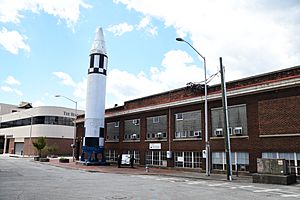
Downtown also has the Virginia Museum of Transportation. It has many locomotives built in Roanoke by the Norfolk & Western Railway. These include the famous 1218 and 611 steam engines. The museum also displays a US Army Jupiter rocket and exhibits on aviation and automobiles.
The old Norfolk and Western Passenger Station now holds two museums. The O. Winston Link Museum shows photos of steam-era railroads. The History Museum of Western Virginia is also there. The station building itself is historic.
Performing Arts and Theaters
The Berglund Performing Arts Theatre is a large venue with 2,150 seats. It hosts concerts, Broadway shows, and comedy acts. It also holds the Miss Virginia pageant. Roanoke has many public artworks, including a 30-foot (9 m) stainless steel sculpture called "In My Hands."
The Jefferson Center used to be a high school. It was renovated in the 1990s. Now it has offices for non-profits and city departments. It also has event spaces and the Shaftman Performance Hall, a 925-seat theater.
The Dumas Center for Artistic and Cultural Development opened in 2006. It is in the former Dumas Hotel. This hotel used to host famous Black artists like Louis Armstrong and Nat King Cole. The renovated center has an auditorium with over 200 seats.
The Mill Mountain Theatre has performed in the Roanoke Valley since 1964. It is a regional theatre located in Center in the Square. It has a main stage and a smaller "black box" theater for new plays.
Roanoke also has the Showtimers Community Theatre, which started in 1951. The Virginia Children's Theatre began in 2008. It performs shows for younger audiences, often based on children's books.
Opera Roanoke is Southwest Virginia's only professional opera company. It started in 1976. The Roanoke Symphony Orchestra has been its official orchestra since 2004. The orchestra performs at various venues in the city.
Popular Places to Visit
Roanoke is the largest city on the Blue Ridge Parkway. This scenic road is part of the National Park System. An exit from the Parkway leads to the Roanoke Star. This huge, 88.5-foot (27 m) tall star lights up a mountain in the city. Also on the mountain is Mill Mountain Zoo. It has over 170 animals.
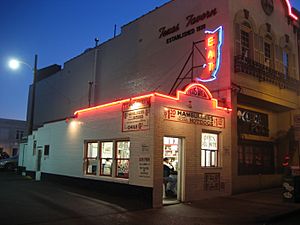
The Basilica of St. Andrew is a beautiful church on a hill overlooking downtown. It was built in 1900 and is known for its Gothic style. Below the church is the Hotel Roanoke. This historic hotel was built in 1882 by the Norfolk and Western Railway. It is known as the "Grand Old Lady."
A bridge connects the Hotel Roanoke to the city's historic market building. The farmers' market started in 1882. It is the oldest open-air market in Virginia that has been running continuously. Nearby is Fire Station No. 1. It used to be the oldest continuously operating fire station in the state. Two blocks away is Texas Tavern, a small, famous restaurant that has been open since 1930.
Festivals and Events in Roanoke
Roanoke hosts many annual festivals and events.
- A St. Patrick's Day parade happens every March.
- Pride in the Park celebrates the LGBTQ+ community in April.
- In May, there's the Local Colors festival, celebrating different cultures.
- The city's Strawberry Festival and the Down by Downtown music festival also happen in May.
- Memorial Day weekend brings the Festival in the Park to Elmwood Park.
Later in the year, Elmwood Park hosts the Henry Street Heritage Festival. This event helps raise money for the Harrison Museum of African American Culture. The Go Outside Festival (GO Fest) is a free event in October. It celebrates outdoor activities in the region. In December, the city holds the multi-week Dickens of a Christmas. This event has a Christmas tree lighting, a parade, and horse-drawn carriage rides.
Sports and Recreation in Roanoke
Sports Teams and Events
The Virginia Squires basketball team played some home games in Roanoke in 1971–1972. This was the only major league sports team to play regularly in the city. Julius Erving, a famous basketball player, played his first professional season with the Squires.
Minor league baseball has a long history in the Roanoke Valley. From the 1940s to 1950s, Roanoke had a team linked to the Boston Red Sox. Since 1955, nearby Salem has hosted the local minor league baseball team. As of 2023, it is the Salem Red Sox.
Minor league hockey returned to Roanoke in 2016. The Roanoke Rail Yard Dawgs of the SPHL started playing. In 2023, the team won its first championship.
Roanoke is close to Virginia Tech. Because of this, it has hosted some college sports events. From 1977, Roanoke was a main place for the annual basketball game between Virginia Tech and the Virginia Cavaliers. From 1913, Roanoke also hosted an annual football game between Virginia Tech and the Virginia Military Institute. This game was a holiday tradition until 1971.
Roanoke's location in the Blue Ridge Mountains makes it great for sports events. Since 2010, the Roanoke Outside Foundation has held the Blue Ridge Marathon. This race is known for being very challenging due to the hills. The USA Cycling Amateur Road National Championships were held here in 2022 and 2023. An Ironman 70.3 triathlon event also took place in the region from 2021 to 2023.
Parks and Outdoor Fun
Roanoke has 60 parks within its city limits. The parks and recreation department manages almost 14,000 acres (5,700 ha) of public land. Highland Park is the city's oldest park, bought in 1902. Elmwood Park in downtown Roanoke became the second park in 1911. It has a special Japanese magnolia tree. As of 2023, Elmwood Park has the city's main library and an amphitheater.
Roanoke has a large network of paved greenways. These are for walking, running, and cycling. The idea for greenways started in 1907. But construction didn't begin until 1995. Now, there are 26 miles (42 km) of greenways across the Roanoke Valley. The longest part runs 12 miles (19 km) along the Roanoke River. As of 2023, Roanoke has over 100 miles (160 km) of trails and greenways.
Learning and Getting Around in Roanoke
Education in Roanoke
Two four-year private colleges are in nearby towns. Roanoke College is in Salem, and Hollins University is in Roanoke County. Virginia Tech and Radford University have main campuses nearby. Both schools have partnered with Carilion Clinic to create medical colleges in Roanoke. The Virginia Tech Carilion School of Medicine started in 2007. Radford University Carilion was established in 2019.
The Roanoke Higher Education Center opened in 2000. It offers over 150 programs. These range from high school equivalent degrees to doctorates. Virginia Western Community College is in the city. It offers associate degrees and helps students transfer to four-year colleges. ECPI University, a private school, also has a campus in Roanoke.
Roanoke City Public Schools manages the local public schools. The two main public high schools are Patrick Henry High School and William Fleming High School.
Roanoke Catholic is a well-known parochial school. It started in 1889. Private non-parochial schools include Community High School of Arts and Academics.
Media and News
The city's daily newspaper is The Roanoke Times. It has been published since 1886. The Roanoke Star and Cardinal News are online newspapers. They help cover local news.
The weekly Roanoke Tribune focuses on the city's African-American community. The Roanoker is a magazine about the area's lifestyle.
Roanoke and Lynchburg share a television market. This means they get the same TV channels. Roanoke has channels for all major networks. The Roanoke-Lynchburg area also has many radio stations.
The reality television show Salvage Dawgs was based in Roanoke. The show followed a company that finds and reuses old architectural pieces.
Transportation in Roanoke
Interstate 581 is the main north-south road in Roanoke. It connects the city to Interstate 81 to the north. U.S. Route 460 is the main east-west road. It connects Roanoke to Lynchburg and Christiansburg. U.S. Route 11 also passes through the city.
The Roanoke–Blacksburg Regional Airport is in the northern part of the city. It is the main airport for Southwest Virginia. Major airlines like American Airlines, United Airlines, Delta, and Allegiant Air use it.
Roanoke is famous for its rail history. But Amtrak stopped passenger train service in 1979. In 2011, Roanoke started a bus service to connect riders to the Amtrak station in Lynchburg. This showed Amtrak there was still demand. In 2017, Amtrak brought passenger service back to Roanoke. It has been so successful that a second daily train was added in 2022.

Even though Norfolk Southern moved its main offices, Roanoke is still a big hub for its freight rail system. The railway's Pocahontas Division is based near downtown Roanoke.
The Valley Metro provides bus service in Roanoke and nearby areas. In 2023, the service started operating from a new building downtown. Valley Metro also has bus services to Blacksburg and Ferrum College.
Roanoke has put a lot of effort into improving its cycling paths. It has many paved greenways. It has also added 43 miles (69 km) of marked bike lanes on its main roads. The city has also spent millions on making streets safer for walkers.
Utilities and Healthcare
Appalachian Power Company provides electricity to Roanoke. The Western Virginia Water Authority manages the area's water and wastewater services. This group was formed in 2004 to manage water resources better.
Roanoke is the main center for healthcare in Western Virginia. It serves about one million people. Carilion Clinic is the largest healthcare provider. It has over 750 doctors and eight hospitals. The region also has the Lewis-Gale Medical Center and a Veterans Affairs Medical Center.
Famous People from Roanoke
Roanoke's Sister Cities
Roanoke has six sister cities around the world:
 Florianópolis, Brazil
Florianópolis, Brazil Kisumu, Kenya
Kisumu, Kenya Lijiang, China
Lijiang, China Opole, Poland
Opole, Poland Saint-Lô, France
Saint-Lô, France Wonju, South Korea
Wonju, South Korea
In 2023, Roanoke paused its sister city connection with Pskov, Russia. This was due to the ongoing conflict in Ukraine.
Images for kids
See also
 In Spanish: Roanoke (Virginia) para niños
In Spanish: Roanoke (Virginia) para niños


